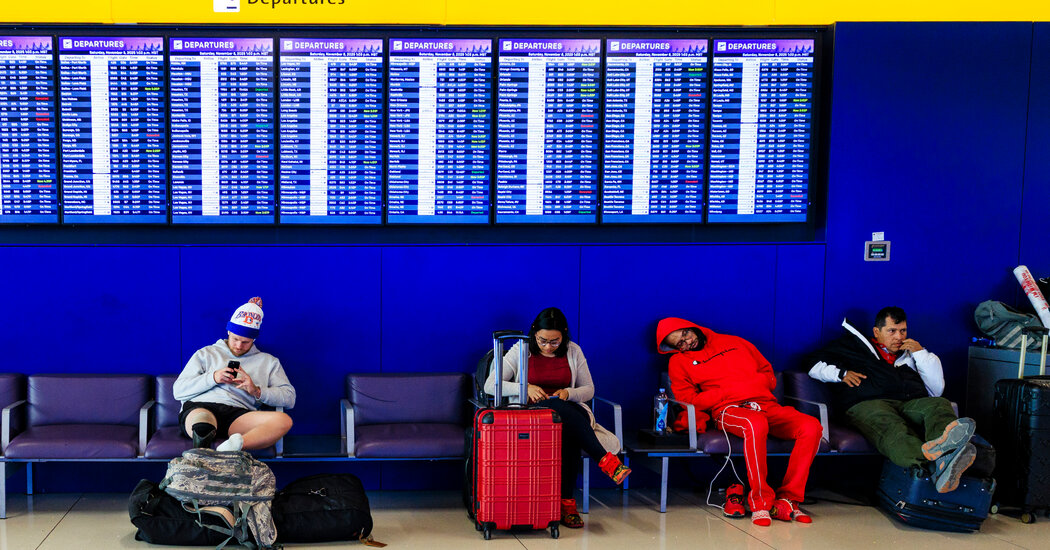Copyright The New York Times

Travelers reported modest hassles at airports across the country on the second day of flight cancellations prompted by the government shutdown, as officials braced for increased snarls to air traffic in the coming days and weeks if it continues. Roughly 5 percent of flights in the United States were canceled on Saturday, slightly more than the day before. Smaller, regional carriers were the most affected, with some reporting the cancellation of 8 or 9 percent of their flights. Frustrations among travelers were growing even as many of them said airlines were coping as best they could with the disruption to their schedules. For Addy Lapp, the changes meant passing the time at a Dunkin’ at the airport in Greenville, S.C. She had been trying to get back to San Antonio, where she attends college, since Friday, when her flight was delayed three times before being canceled. She returned to the airport on Saturday, and was booked on a new flight, but one with a connection through Houston. “I missed work and had to call my manager last night,” said Ms. Lapp, 19, who works in a coffee shop. The scenes at airports across the country reflected a slow-moving crisis that was likely to grow worse as the Federal Aviation Administration required airlines to reduce an increasing number of flights. The order from the Trump administration is in response to the ongoing government shutdown that federal officials say has strained air traffic controllers who have been working without pay for more than a month. Sean Duffy, the secretary of transportation, said on Friday that one in five flights could be canceled by Thanksgiving, typically one of the busiest times for travel in the United States. The cancellations were concentrated among three of the largest carriers, American Airlines, Delta Air Lines and United Airlines, which dominate many of the busiest airports. But those airlines focused the cuts on regional flights, many of which are operated by subsidiaries or other smaller carriers like SkyWest Airlines and Republic Airways, the two operators most affected by the cuts. More than 190 of the roughly 1,100 canceled flights on Saturday were scheduled to be flown by SkyWest on behalf of American, Alaska Airlines, Delta and United, according to FlightAware, a flight-tracking site. By the afternoon, 115 flights eliminated by American, Delta and United were intended to be flown by Republic. In a statement, SkyWest said that cancellations were “being managed days in advance” and that the company would operate a “vast majority” of its flights. Republic did not respond to a request for comment. Those regional airlines still typically receive compensation when flights are canceled, though they may face some added costs to move planes and crews into place for other flights. Chris Hamel and his wife, Cally Razes, were at O’Hare International Airport in Chicago waiting to pass security for a flight to West Palm Beach, Fla. The couple owns two ice cream shops in Barrington, Ill., and were headed to an industry trade show. Their flight was on schedule, but they were worrying about the return trip on Thursday, when a higher percentage of flights nationwide were expected to be trimmed if the government does not reopen. Mr. Hamel said he blamed lawmakers of both parties for the shutdown. “Both sides are stupid,” he said. “No one side is more right than the other. They are supposed to be working for the people, but the people are the ones getting the short end of the stick.” Newark Liberty International Airport in New Jersey was one of the most affected hubs on Saturday, with 13 percent of flights canceled and more than a third delayed. Maddie Wen, 34, a software engineer who lives in Jersey City, was having a poor start to her long trip to Taipei, Taiwan. She was supposed to route through San Francisco, but her early morning flight was delayed to midday, which would have meant missing the connection. “Now, they say they’re going to connect us through Tokyo, but I’m not confident that’s going to happen,” she said. Some travelers, if their journeys were short enough, were thinking about other ways of making the trip. Jennifer Hayden, who coaches the women’s rowing team at St. Ignatius College Preparatory in San Francisco, was traveling on Saturday with 27 high school athletes to a competition in San Diego. By late morning her flight was still a go, but she had a bus on standby. “I did contact a bus company to make sure that, if we were to call them, they could perhaps pick us up at the airport and take us,” she said. “I just needed to have a backup plan.” As the shutdown persists, many Americans are feeling its effect in a multitude of ways. Marcelo Camacho took a flight to LaGuardia Airport from Miami on Saturday afternoon, and while he made it back to New York, he had to sit on the tarmac for about an hour after landing. Mr. Camacho receives food stamps through the SNAP program, another casualty of the government shutdown. As a Latino, the government’s crackdown on immigration has also made him fearful. All of this was running through his mind while he sat. “You start being more angry,” he said. “My SNAP hasn’t coming in. You’re afraid going to the store looking Latino. It’s very tiring. That crosses your mind when you’re waiting on a plane.” Niraj Chokshi , Coral Murphy Marcos , Robert Chiarito , Nate Schweber , Mark Bonamo and Allison Hill contributed reporting.



